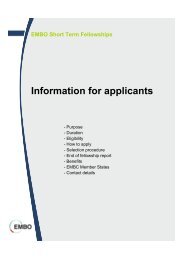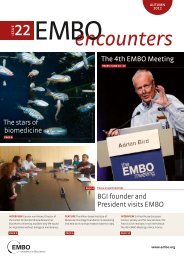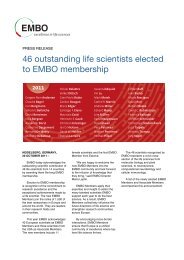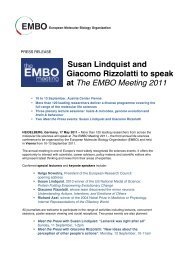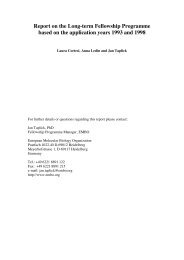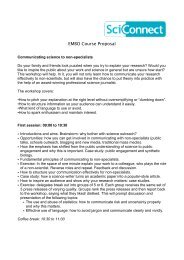EMBO Fellows Meeting 2012
EMBO Fellows Meeting 2012
EMBO Fellows Meeting 2012
You also want an ePaper? Increase the reach of your titles
YUMPU automatically turns print PDFs into web optimized ePapers that Google loves.
Bogdan Beirowski<br />
<strong>EMBO</strong> <strong>Fellows</strong> <strong>Meeting</strong> <strong>2012</strong><br />
Sirtuin 2 in Schwann cells modulates peripheral myelination through Par-3 polarity<br />
signaling<br />
Abstract<br />
Schwann cells (SCs) are a type of supportive tissue in the vertebrate peripheral nervous system that associate<br />
with axons to produce a multilayered membrane known as myelin. The highly orchestrated process of myelin<br />
formation occurs during development and after nerve injury in the peripheral nervous system. Myelin sheaths<br />
allow neuronal signals to pass rapidly along nerves, crucial for normal movement and sensation. Impeded<br />
myelination underlies several peripheral neuropathies, neurological disorders characterized by abnormal nerve<br />
function. While some disease genes and mechanisms underlying inherited neuropathies have been elucidated<br />
in the last decades, the processes leading to neuropathies secondary to metabolic derangements such as<br />
diabetes remain mostly enigmatic. The compromised myelin formation and axon damage in these conditions<br />
could be due to changes in molecular pathways that are regulated by SC energy metabolism. We used global<br />
expression profiling to examine peripheral nerve myelination and identified the deacetylase Sirt2 as a protein<br />
likely to be involved in myelination. Sirt2 is a member of the conserved sirtuin family of NAD+ dependent<br />
deacetylases whose activity to control a multitude of molecular processes is determined by the energetic and<br />
metabolic state of the cell. Abnormal sirtuin activity is believed to play a significant role in metabolic diseases<br />
like diabetes, and manipulation of sirtuin function has promising potential as therapy. Here, we show that Sirt2<br />
expression in SCs is correlated with that of structural myelin components during both developmental<br />
myelination and remyelination after nerve injury. We discovered that Sirt2 deacetylates Par-3, a master<br />
regulator of cell polarity. The deacetylation of Par-3 by Sirt2 decreases the activity of the polarity complex<br />
signaling component aPKC in SCs. Consistent with the idea that proper establishment of SC polarity is<br />
necessary for normal wrapping of axons with myelin, we found that manipulation of Sirt2 levels, and the<br />
polarity pathway it affects, results in myelination deficits in vivo. In conclusion, we describe a novel type of<br />
molecular crosstalk in myelin-forming SCs that involves Sirt2 and a central polarity pathway. This finding may<br />
help to improve our understanding of mechanisms underlying neuropathies characterized by impaired SC<br />
myelination and metabolic disease. Moreover, our study raises the intriguing possibility that the identified<br />
Sirt2/Par-3/aPKC pathway provides a link between changes in myelination and nutritional alterations, aging,<br />
and physical exercise.<br />
Laboratory of Jeffrey Milbrandt<br />
Department of Genetics, Washington University School of Medicine, St. Louis, MO, USA<br />
14-17 June <strong>2012</strong>, Heidelberg, Germany




